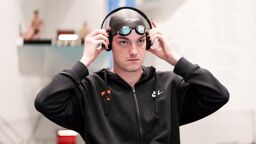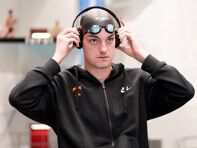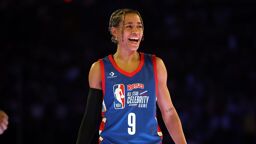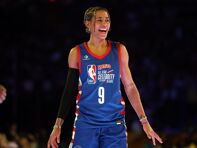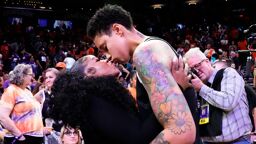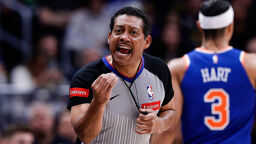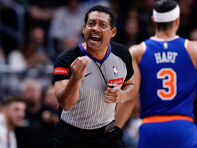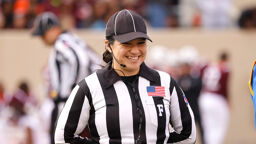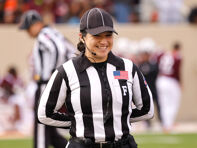On January 24, leading professional bowler Chris Barnes went down in flames to a woman — Kelly Kulick — in the 2010 PBA's Tournament of Champions. And David Whitley over at FanHouse couldn't contain himself as he pooh-poohed Kulick's performance. He started by crowing that "bowling is not an athletic event." Then he alleged that men are "better equipped for activities requiring speed, strength, endurance….The best female cannot beat the best male except in horse racing."
Whitley needs to hold his horses. Women can –and do — have the edge over men in some endurance events. Ultra-marathon running and long-distance swimming are two of them.
On January 24, leading professional bowler Chris Barnes went down in flames to a woman — Kelly Kulick — in the 2010 PBA's Tournament of Champions. And David Whitley over at FanHouse couldn't contain himself as he pooh-poohed Kulick's performance. He started by crowing that "bowling is not an athletic event." Then he alleged that men are "better equipped for activities requiring speed, strength, endurance….The best female cannot beat the best male except in horse racing."
Whitley needs to hold his horses. Women can –and do — have the edge over men in some endurance events. Ultra-marathon running and long-distance swimming are two of them.
When I was running marathons in the late ’60s and early ’70s, everyone in long-distance running watched in amazement as the 100-mile runs became the new frontier — and the occasional woman was beating men in these grueling events.
We noticed an interesting phenomenon. The gap between world bests by women and men runners was widest in the sprints, thanks mainly to the male edge on short-twitch muscle performance. But as the distances lengthened, the gap narrowed. At 50 miles, that gap got very narrow, and at 100 miles it was sometimes even-steven. Clearly other factors besides short-twitch were in play. Women appeared to have a biochemical edge over men. Among other things, they have a higher percentage of body fat than men. The experts theorized that, once the store of glycogen in the muscles is exhausted during a very long race, women's bodies are better able to break down body fat and burn it directly as a new energy source. The longer the race, the more of an edge a woman might have.
These days, Laura McDonough is one of these super-endurance females. In the 2009 Resurrection Pass 100-miler in Alaska, she logged a winning time of 21:58. Second place went to a man, Eliseo Marquez, who crossed the finish line 1 hour 27 minutes behind her. This is not winning by a nose, folks. And it was no fluke — Laura had pulled off a similar feat in 2005 in this same race.
Last but not least, there is the Khiel's Badwater Ultra Marathon, billed by its promoters as "the world's toughest foot race." Slogging along in temperatures that sometimes hit 130F, the competitors cover 135 miles nonstop from the lowest point in the Western hemisphere — Badwater, in Death Valley, below sea level — to the highest point, which is over 12,000 feet on Mt. Whitney — an effort that is guaranteed to take the starch out of the toughest human of either gender. Several women have beaten men to win the Badwater — the most recent being Pamela Reed, who won it in both 2002 and 2003. Her 2003 winning time was 28;56;52. Behind her, three other women finished in the top 20, and 12 in the top 50, showing the female depth in the field.
Says one Badwater runner: "It's an amazing feat to merely finish… and a testament to the strength of women that they have outperformed men so many times."
Upping the ante is the "double Badwater," which is the same course out and back – nearly 300 miles. The first woman to complete it was Rhonda Provost, who did it in 143:45, which is just under six days. (Days!)
In recent years, science scrutinizes the why of these stunning performances by women. PubMed has an interesting page where it collects links to studies comparing men's and women's endurance performances over distance. PubMed opines that there's a tipping point at 66 km. The evidence, according to PubMed, "supports the hypothesis that women ultramarathon runners have greater fatigue resistance than do equally trained men whose performances are superior up to the marathon distance."
The same principle applies in long-distance swimming, as I realized a few years ago when I was writing about Diana Nyad, pioneering lesbian in this extreme sport. Here, body fat gives women an edge as well — especially in cold-water swimming where body heat has to be maintained and buoyancy is important. In recent years, the most outstanding distance swimmer has been Lynne Cox. At age fifteen and sixteen, this Boston girl broke both the men's and women's world records for swimming the English Channel. In 1974, she broke men's records again while swimming from the California coast to Catalina Island.
Back to Kelly Kulick's bowling performance. She is the first woman to win a PBA tour title. In the finals against Barnes, who was Player of the Year in 2008-9, she scored a devastating 265-195 win. Afterwards, Billie Jean King had this to say: "Kelly Kulick's win today is not only historic, it serves as a motivational and inspirational event for girls and women competing at all levels all around the world."
Kulick's win could happen because, six years ago, the PBA bravely opened its doors to women players after the PWBA collapsed. Women did have to qualify to play — and Kulick was the first to do so. She said, "Words can't even describe the feeling. I feel confident I can be a good enough competitor to stay out on Tour." Though she struggled for the next few years to achieve that goal, she finally delivered big-time the other day.
So — am I advocating that men's and women's divisions be eliminated in all sports? No way. I agree that there's a place for the two divisions in many sports — simply because, on the broad front, that performance gap between the genders does exist in certain events. Woman/woman competition does give more females a chance to win or place more of the time.
But it’s time for the sports world to get past the notion that competition is an either-or thing when it comes to gender. There’s a lot that we still don’t know about the female human being — and what she can achieve, if she gets the right training and enough support. Fifty years ago, nobody would have believed that a woman could even run 135 miles, let alone beat a man doing it. Time has proven them wrong. At the shorter distance of 26.2 miles, U.S. women were first approved for the marathon in 1971. Once they got the full support of sports authorities, they were on fire and lowered their world times drastically between 1971 and today.
At CounterPunch several years ago, Mark Donham had a more enlightened take than David Whitley. He said: "Women are here to stay in regard to their skill levels in traditionally male activities. I say let women compete against men, starting in tennis, golf, and other such sports. Sure, the best men will currently beat the best women most of the time, but competition makes the lesser talents better. If we keep supporting women's athletics and let them start competing against men, it is only a matter of time before they start competing seriously with the men. The time will come when we have world champion women, not just a woman's champion. This is a real test of our constitution."
In short, it's important for sports to continue creating a greater diversity of arenas where women and men can compete with each other in the more strenuous and athletic sports. Hair-raising challenges and sudden surprising achievements push us towards scientific discovery of why things happen the way they do in sports. In turn, discovery tells us more about what we can do. Isn't that what sports are supposed to be about?
Copyright 2009 by Patricia Nell Warren. All rights reserved.







